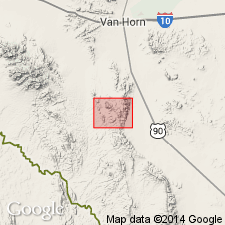
- Usage in publication:
-
- High Lonesome Tuff
- Modifications:
-
- First used
- Geochronologic dating
- Dominant lithology:
-
- Tuff
- AAPG geologic province:
-
- Permian basin
Summary:
First published use for excellent, thick exposures on High Lonesome Peak, Culberson Co, TX, Permian basin. Formerly correlated with Pantera Trachyte of the Wylie Mountains to the east and later called Pantera Trachyte. Type section is on north side of the peak. Occurs predominately in the Van Horn Mountains of west TX. Also occurs in Wylie Mountains. Is a densely welded rhyolitic ash-flow tuff which contains 6-12 percent alkali feldspar phenocrysts in a groundmass of glassy or devitrified shards. Layering suggests at least 5 ash flows or cooling breaks; each one is probably a single ash flow. Is as much as 139 m thick within its source area, the Van Horn Mountains caldera, as measured at its type; outside the caldera, it is much thinner--a typical thickness is 12 m. Pinches out in northern Sierra Vieja. Is densely welded everywhere observed. Includes about 1 cubic km of caldera fill. Has an average thickness of 100 m over the 10 cubic km area of the caldera. Overlain by unnamed tuffaceous sediments and trachyte lava flows. Overlies Hogeye Tuff. Geologic map. K-Ar age of 36.9 +/-0.8 m.y., or Oligocene. Distribution map. Correlation chart.
Source: GNU records (USGS DDS-6; Denver GNULEX).
For more information, please contact Nancy Stamm, Geologic Names Committee Secretary.
Asterisk (*) indicates published by U.S. Geological Survey authors.
"No current usage" (†) implies that a name has been abandoned or has fallen into disuse. Former usage and, if known, replacement name given in parentheses ( ).
Slash (/) indicates name conflicts with nomenclatural guidelines (CSN, 1933; ACSN, 1961, 1970; NACSN, 1983, 2005, 2021). May be explained within brackets ([ ]).

